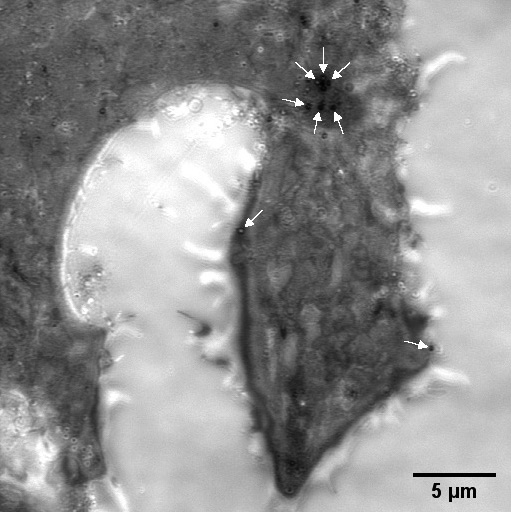The Coronascope – Scientists at Max-Planck-Zentrum für Physik und Medizin observe an infection with Sars-CoV-2 live

An iScat image of a human cell, the arrows point to individual Vaccinia viruses (not yet Corona viruses!) in the infected cell
A kind of video surveillance could contribute to getting an insight into the life cycle of the coronavirus: Researchers at Max Planck Institute for the Physics of Light (MPL) and Friedrich-Alexander University Erlangen-Nuremberg (FAU) want to monitor live how cells get infected with Sars-CoV-2. To do this, they are installing an especially constructed microscope in a virological high-security laboratory. The imaging technique named iScat enables the Erlangen scientists to observe the interaction of living cells and viruses over a longer period of time with high spatiotemporal resolution. The cooperation within the Max-Planck-Zentrum für Physik und Medizin could thus also aid in the development of therapies for Covid-19.
An infection is a race, and the corona pandemic illustrates dramatically that it is often a matter of life and death. On a large scale, this is particularly true for all the efforts to curb the Covid-19 pandemic. But this is also the case on a small scale, when an infected person's immune system tries to overcome the pathongen. If immediately after infection the virus replicates faster than the body's own defence is able to eliminate it, the disease will break out. "An important factor in this race is how long it takes for the virus to enter a human cell, to multiply there and set free a new generation of viruses, which then in turn infect other cells," explains Vahid Sandoghdar, director at the Erlangen Max Planck Institute for the Physics of Light and head of a chair for experimental physics at FAU. "How the individual steps work on the single cell level is still unclear."
That is why his team now wants to track the propagation cycle of the virus together with researchers led by Klaus Überla, director of the Virological Insitute of the University Hospital and head of the chair for Clinical and Molecular Virology at FAU. "I am looking forward to the interesting collaboration," says the virologist. The medical and physical experts also want to directly observe in a cell how drug candidates influence the cell-virus-interaction and the virus' reproduction.
The cooperation for research on Sars-CoV-2 is an example for the work at the Max-Planck-Zentrum für Physik und Medizin. In it, scientists from MPL, FAU, and the University Hospital Erlangen use physical principles and methods to tackle fundamental question in medicine. They hope a microscopic video surveillance of the coronavirus will not only provide better understanding of the infection, but also starting points for therapy.
More information can be found in the full press release (German).
Contact
Edda Fischer
Head of Communication and Marketing
Phone: +49 (0)9131 7133 805
MPLpresse@mpl.mpg.de





